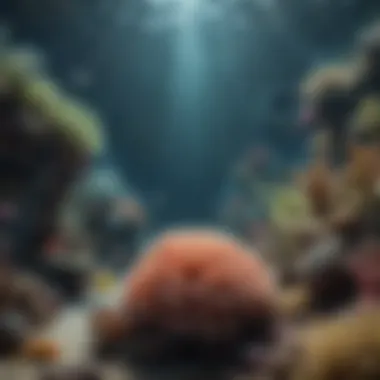The Ocean's Crucial Role in Our Ecosystem


Nature Topic Overview
The ocean is a vast and mysterious place that covers over 70% of our planet. It is not just an enormous body of water; it plays a crucial role in our planet's ecosystem. The ocean affects climate, supports many forms of life, and provides resources for everyone. In this section, we will explore why the ocean is essential and how it impacts our daily lives.
The ocean has different layers, each supporting unique marine life. From the shallow coastal areas to the dark, deep sea, each section of the ocean hosts various species. Major currents in the ocean not only control the marine habitat but also regulate the weather patterns on land. Without a healthy ocean, the entire balance of life on Earth can be disrupted.
Understanding the ocean's importance is vital as we face numerous environmental challenges today. Pollution, climate change, and overfishing threaten ocean health. Learning about our oceans can inspire us to protect them.
Fun Facts and Trivia
Did you know that the ocean is home to more than 230,000 known species? Here are some intriguing facts:
- The ocean can reach depths of over 36,000 feet in places like the Mariana Trench.
- The Great Barrier Reef, located in Australia's Coral Sea, is the largest living structure on Earth.
- Some fish can change color to blend in with their surroundings, a skill known as camouflage.
Learning about the ocean can be fun! You can explore interactive maps or watch videos of ocean life to make learning exciting.
Wildlife Explorations
The ocean is teeming with life. Some notable marine species include:
- Dolphins: Known for their intelligence and playful behavior, dolphins are social animals that live in groups.
- Coral Reefs: While they are not animals, coral provides habitat for many sea creatures. Fish, snails, and sea turtles live among them.
- Sharks: These formidable predators come in many species and play a vital role in maintaining the health of marine ecosystems.
Each ocean area supports distinct life forms, from plankton near the surface to giants like blue whales in the deep waters. Engaging quizzes about ocean animals can enhance understanding and retention.
Environmental Awareness
Conservation is essential for protecting ocean life. Here are some reasons why:
- Oceans absorb carbon dioxide, helping to regulate climate.
- Healthy oceans provide food for millions of people.
- The ocean is a vital part of cultural identity for many communities.
Tips for kids to help protect the ocean:
- Reduce plastic use. Bring reusable bags when shopping.
- Take part in beach cleanups in your local area.
- Educate friends and family about the importance of clean oceans.
We all have a role in conserving the earth’s oceans.
DIY Nature Activities
Here are some fun activities you can do at home to learn more about the ocean:
- Make a Mini Ocean in a Bottle: Take a plastic bottle, fill it with water, and add sand and small ocean toys to create your own ocean scene!
- Ocean Craft Activity: Use seashells and colored paper to make ocean-themed art. This helps connect creativity with ocean learning.
- Outdoor Exploration: Visit a nearby beach or lake. Observe the water and any wildlife. Keep a journal of your findings.
By engaging in these activities, you can deepen your understanding of the ocean and its importance.
Preamble to Oceanic Significance
The oceans cover approximately 71% of the Earth's surface. They play a central role in maintaining life on our planet. Describing their importance helps us understand why oceans deserve our attention and protection. This section introduces the significance of oceans by defining what they are and discussing their vast coverage.
Defining the Ocean
An ocean is a vast body of salt water, larger than a sea. Generally, oceans are categorized into five main areas: the Pacific Ocean, Atlantic Ocean, Indian Ocean, Southern Ocean, and Arctic Ocean. Each ocean has distinct features and ecosystems. These ecosystems are home to a diverse range of species, contributing to the overall health of our planet.
Understanding the ocean involves more than knowing its size or how it is divided geometrically. It also involves recognizing its role in controlling climate, housing trillions of marine organisms, and influencing human activities. Each of these elements highlights the complexity of oceanic systems and their interconnectedness with land ecosystems and human life.
Overview of Ocean Coverage
As mentioned, oceans cover 71% of the Earth's surface. This extensive coverage influences weather patterns and climate. The ocean is not just a space filled with water; it is a dynamic, ever-changing environment. The oceans absorb carbon dioxide from the atmosphere and help regulate the global temperature.
Key Points on Ocean Coverage:
- The largest ocean, the Pacific, takes up about 63 million square miles.
- The Atlantic Ocean is the second-largest.
- The Indian Ocean is significant for trade routes.
- The Southern Ocean surrounds Antarctica, playing a vital role in global currents.


This coverage of oceans plays a powerful role in shaping life and the functionality of Earth as a whole. Without understanding this vastness, we can miss the essential role oceans serve in our existence.
The ocean is vital in ensuring that ecosystems thrive and that climate remains stable.
Oceans and Climate Regulation
Understanding the role of oceans in regulating climate is fundamental in grasping their importance. Oceans cover more than 70% of the Earth's surface and act as a major component of the climate system. They not only absorb a significant amount of carbon dioxide but also help to regulate temperatures across the globe. The intricate relationship between oceans and climate is vital to life on Earth.
Carbon Sequestration
Oceans play a crucial role in carbon sequestration, which is the process of capturing and storing atmospheric carbon dioxide. Marine plants, particularly phytoplankton, absorb carbon dioxide during photosynthesis. This process not only reduces the amount of carbon dioxide in the atmosphere but also produces oxygen, which is essential for human and animal life.
- Phytoplankton contribute significantly to global oxygen production.
- The deep ocean stores vast amounts of carbon in the form of organic matter.
- Oceanic currents help in distributing this carbon, allowing for greater absorption throughout the marine environment.
However, the increasing levels of carbon dioxide due to human activities pose risks to this natural process. The oceans are becoming more acidic as they absorb higher amounts of carbon dioxide, which affects marine life. This acidification can harm corals and shellfish, disrupting the ecosystems that rely on them.
Heat Distribution
Oceans are also pivotal in heat distribution. Through currents and convection processes, they help to distribute heat from the equator toward the poles, balancing temperatures globally. This heat exchange is essential for maintaining climate stability.
- Major ocean currents, like the Gulf Stream, influence weather patterns.
- They affect climate zones, impacting not just marine ecosystems but also terrestrial life.
Moreover, the oceans act as a buffer against rapid climate shifts. They store energy from sunlight and wind, which helps moderate atmospheric temperatures. This function is critical as climate change progresses, affecting weather events like storms and droughts.
"The oceans are the Earth's largest carbon sink; they absorb about 30% of the carbon dioxide emitted by humans."
Biodiversity in Marine Ecosystems
Biodiversity in marine ecosystems represents the variety and abundance of life found within ocean habitats. This diversity is essential not only for ecological balance but also for the services that oceans provide to humans. Healthy marine ecosystems contribute to climate regulation, food security, and the overall health of our planet. Here, we explore two crucial aspects of marine biodiversity: coral reefs and marine species diversity.
Coral Reefs as Ecosystems
Coral reefs are one of the most diverse ecosystems in the world. They support thousands of marine species, providing habitat and food for fish, invertebrates, and other creatures. Coral reefs act as natural barriers, protecting coastlines from erosion and storm surges.
The intricate structure of a coral reef is built by tiny coral polyps which, along with algae, form a symbiotic relationship that supports life. These reefs also play a vital role in carbon cycling. They absorb carbon dioxide, helping to mitigate climate change effects. The loss of coral reefs significantly impacts marine biodiversity and disrupts the balance of oceanic systems.
Marine Species Diversity
Marine species diversity includes all forms of life found in the ocean, from the smallest plankton to the largest whales. This diversity is essential for resilient ecosystems, enabling them to adapt to changing environmental conditions. Higher species diversity promotes ecosystem stability and productivity.
Marine organisms contribute to various human needs, including:
- Food resources: Many communities depend on fish and seafood as primary protein sources.
- Medicinal compounds: Some marine species are a source of important medicines, which can treat diseases.
- Biological indicators: The health of marine species can indicate the overall health of marine ecosystems.
In summary, biodiversity in marine ecosystems is not just about the number of species but also their interactions and the roles they play. Protecting this biodiversity is essential for a sustainable future for both the oceans and humankind.
"The health of our oceans directly impacts the health of our planet. It is imperative that we understand and protect marine biodiversity to ensure a thriving ecosystem for future generations."
Oceans and Human Sustenance
Oceans are crucial in supporting human life. They provide essential resources that sustain communities and aid in cultural development. Understanding how oceans contribute to our sustenance is vital for appreciating their role in our lives.
Food Sources from the Ocean
Oceans are a rich source of food. They offer a vast variety of seafood. Fish, shellfish, and sea vegetables are just a few examples. Many people around the world depend on fish as a staple in their diet. Some popular fish include salmon, tuna, cod, and sardines. These types of fish are high in protein and omega-3 fatty acids.
Seafood is not only nutritious but also central to many cultural dishes. For example, sushi from Japan and paella from Spain highlight how different cultures utilize ocean resources.
Here are some key points about food sources from the ocean:
- High Nutritional Value: Seafood is often healthier than meat. It contains vitamins and minerals important for growth and health.
- Sustainable Practices: Overfishing is a concern. Learning sustainable fishing practices is important to maintain fish populations.
- Diversity of Diet: Eating a variety of seafood can introduce different nutrients to our diets.


Economic Impact of Fisheries
Fisheries create jobs and contribute significantly to many economies. They are vital for coastal communities. Fishing provides livelihoods to millions of people globally. It involves both commercial fishing and small-scale fishing operations.
The economic impact is noteworthy:
- Job Creation: Fisheries create direct jobs in fishing, processing, and distribution.
- Export Opportunities: Countries can export seafood. This generates income and boosts the economy.
- Tourism Development: Some places attract tourists for fishing. This brings additional revenue to coastal areas.
"The ocean is not just a source of food. It is also a pathway for trade and a foundation for culture."
Understanding these factors is crucial for fostering an appreciation of the ocean's contributions to human sustenance. By supporting sustainable practices, we ensure that future generations can also rely on the ocean's resources.
Cultural Significance of Oceans
The oceans play an important role in shaping cultural practices and beliefs around the world. For many communities, the sea is not just a body of water; it is a source of identity, history, and connection to nature. Recognizing the cultural significance of oceans helps us appreciate the diverse ways in which people relate to their marine environment.
Oceans influence a variety of societal practices, ranging from traditional fishing methods to artistic expressions inspired by the sea. Communities often develop rituals and festivals that honor the ocean, reflecting their values and traditions.
Cultural Practices Tied to the Sea
Many cultures have deep-rooted traditions that are tied to the ocean. These practices are often passed down through generations, preserving valuable knowledge about marine life and ecosystems.
- Fishing Traditions: Numerous coastal communities rely on fishing as a primary means of livelihood. Techniques are often based on age-old wisdom, tailored to local conditions. This connection to the sea fosters a profound respect for nature.
- Culinary Practices: Seafood is an integral part of many cultures’ diets. Recipes often reflect local fish species and cooking methods, showcasing regional culinary diversity.
- Art and Craft: Ocean resources inspire various art forms, including paintings, carvings, and crafts. Many artists draw inspiration from marine life, creating pieces that resonate with their connection to the sea.
The Ocean in Myths and Folklore
Oceans have always been a source of myths and stories. These narratives often give explanations about the world and its mysteries.
Many cultures feature ocean-themed myths that tell of sea gods, mermaids, and mythical creatures. These tales serve several purposes:
- Morality Lessons: They often encompass moral lessons and admonishments regarding human behavior toward nature.
- Cultural Identity: Myths help build a sense of identity for communities, linking generations to their ancestral roots and shared heritage.
- Understanding Natural Phenomena: Stories may also explain natural events like storms and tides, making the unpredictable nature of the sea more understandable for people.
Understanding the cultural significance of oceans enhances our appreciation for marine environments and the diverse ways human lives are intertwined with these vast waters.
Economic Activities Related to Oceans
Oceans provide numerous and vital economic opportunities. From tourism to marine trade, these activities play a crucial role in economic stability and growth. Understanding the dynamics of these activities is essential for realizing how they benefit communities and nations alike.
Tourism and Recreation
Tourism related to oceans is a major source of income for many countries. Coastal areas attract millions of visitors each year, seeking beaches, marine parks, and aquatic sports. Activities like snorkeling, scuba diving, and whale watching entice tourists worldwide. The beauty of the ocean and its biodiversity draw people into experiencing nature.
Tourism can boost local economies significantly. Towns and cities near oceans often depend on revenue from hotels, restaurants, and shops that cater to tourists. For many families, this is a source of livelihood. It creates jobs and provides opportunities for businesses to grow.
However, it is also vital to manage this tourism sustainably. Overcrowding can damage delicate marine ecosystems, leading to problems such as coral reef degradation. Responsible tourism practices ensure that we can enjoy the ocean's beauty while protecting it for future generations.
"The ocean not only inspires awe but also sustains lives through its endless resources and potential for enjoyment."
Marine Trade
Marine trade encompasses the exchange of goods and services that originate from the ocean. This includes fish, seafood, and marine minerals. Many countries rely on fishing fleets for their economy, sending catches to markets domestically and internationally. The fishing industry provides food and jobs for millions of people.
In addition to fish, marine trade also involves shipping goods across oceans. Shipping is the backbone of global trade, where cargo ships transport products to different parts of the world. Ports serve as key points for this trade, linking various economies and enabling businesses to flourish.
However, marine trade comes with responsibilities. Sustainable practices must be followed to prevent overfishing and exploitation of marine resources. Protecting ocean health is essential for the sustained benefits from this economic activity.
Ocean Conservation Efforts
The oceans, which cover over 70% of our planet, are facing severe challenges. Conservation efforts are crucial to protect marine environments and ensure their health for future generations. This section highlights the vital aspects relating to marine conservation, its benefits, and the significant considerations we must take into account.
Threats to Marine Environments


Marine ecosystems encounter many dangers that threaten their very existence. Climate change is one of the biggest threats, causing ocean temperatures to rise. Warmer waters affect marine life, disrupting breeding and feeding patterns. Ocean acidification, resulting from increased carbon dioxide, makes it difficult for organisms like corals and shellfish to build their shells and skeletons. These changes threaten the biodiversity of ocean life.
Overfishing also poses a severe risk. When fish populations are harvested faster than they can reproduce, it leads to imbalance in marine ecosystems. Bycatch from fishing activities often kills unintended species. Pollution, especially plastic waste, contaminates the ocean. It harms aquatic animals and enters the food chain, affecting human health as well.
Furthermore, habitat destruction from coastal development impacts vital areas like mangroves and coral reefs. These environments support diverse species and protect coastlines from erosion.
Key Threats to Monitor:
- Climate change
- Ocean acidification
- Overfishing
- Pollution, especially plastics
- Habitat destruction
Global Initiatives for Protection
Various global initiatives work to tackle these threats and conserve marine environments. Organizations like the United Nations have established programs aimed at sustainable development of oceans. The United Nations' Sustainable Development Goal 14 calls for life below water to be conserved and sustainably used.
The Marine Protected Areas (MPAs) program helps to safeguard crucial habitats. These areas restrict human activity and allow ecosystems to recover and thrive. Moreover, various non-profit organizations focus on raising awareness and funding for ocean conservation projects.
Community efforts also play a significant role. Local groups often work on beach cleanups, wildlife rehabilitation, and educational programs that engage the public.
"Protecting our oceans is not just a choice. It's a necessity for our planet's health and for future generations."
Notable Initiatives:
- United Nations' Sustainable Development Goal 14
- Marine Protected Areas (MPAs)
- Local marine conservation groups
The Future of Oceanic Health
Understanding the future of ocean health is crucial for all living beings on Earth. The oceans play a fundamental role in maintaining ecological balance. They absorb carbon, regulate temperature, and support countless species. However, current trends signify serious threats to this vital resource. Addressing these challenges and taking proactive steps are essential for ensuring a healthier ocean.
Impact of Climate Change on Oceans
Climate change has considerable effects on the oceans. As global temperatures rise, oceans absorb most of the extra heat and CO2. This leads to various changes:
- Increased Water Temperatures: Warmer waters affect marine life, including fish and coral reefs. Many species struggle to survive in temperatures outside their normal range.
- Ocean Acidification: More CO2 makes the ocean more acidic. This change negatively impacts shellfish and coral, affecting the entire ecosystem.
- Sea Level Rise: Melting ice caps contribute to rising sea levels, which can lead to habitat loss for coastal species and affect human populations living near oceans.
These impacts are not just scientific concerns; they affect food sources and economies around the world.
Role of Technology in Conservation
Technology holds great promise in ocean conservation. Advancements provide new ways to research, monitor, and protect marine environments. Specific tools include:
- Remote Sensing: Satellites and drones track changes in ocean temperatures and habitats. This data helps in making informed decisions about conservation efforts.
- Artificial Intelligence: AI is used to analyze vast amounts of data on marine species and ecosystems. This can pinpoint areas most in need of protection.
- Sustainable Fishing Technologies: Innovations are making fishing practices more sustainable. Fish finders help optimize catch limits, reducing overfishing, while bycatch reduction devices minimize harm to non-target species.
"Technological advancements present an opportunity to create a sustainable future for our oceans."
Adopting these advancements can help in understanding and restoring ocean health. It requires collaboration from governments, organizations, and individuals.
Closure
Understanding the role of the ocean in our world is paramount. The ocean influences climate, sustains life, and shapes cultures. It is a vast source of resources, food, and inspiration. Yet, it faces alarming threats due to human activities and climate change. Recognizing the ocean's importance initiates a sense of responsibility towards its protection.
Summary of Ocean Importance
The ocean covers about 71% of the Earth's surface. It is not just a body of water; it is the heart of our ecosystem.
- Climate Regulation: The ocean absorbs carbon dioxide and regulates temperatures. It helps in distributing heat around the planet.
- Biodiversity: It is home to millions of species, many of which are still undiscovered. Coral reefs, for example, are teeming with life and are vital for ecological balance.
- Human Sustenance: Oceans provide food and economic opportunities through fishing and tourism.
- Cultural Significance: Oceans are central to many cultures, featuring in folklore, traditions, and lifestyles.
In summary, the ocean's health directly influences our planet's future. Protecting it is not optional; it is essential.
Encouraging Awareness and Action
Education and awareness about the ocean are critical for inspiring action. Here are some approaches:
- Educational Programs: Schools should integrate ocean studies into their curriculum. This encourages children to appreciate marine life and the ocean’s role in our environment.
- Community Outreach: Organizing beach clean-ups can engage local communities. This not only cleans harmful waste but raises awareness about pollution.
- Social Media Campaigns: Platforms like Facebook and Reddit can be used to spread knowledge about ocean conservation. Sharing resources and success stories can motivate followers.
"We’re all connected by the ocean. Our actions, no matter how small, contribute to its health."
By awakening interest in the ocean, we create stewards of the environment who are willing to take action. Protecting the ocean should be a shared commitment for the future of our planet.







